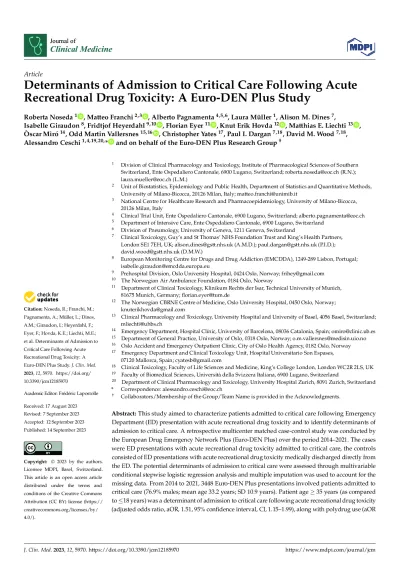Summary
This study aimed to characterize patients admitted to critical care following Emergency Department (ED) presentation with acute recreational drug toxicity and to identify determinants of admission to critical care.
Abstract
This abstract is provided here as a convenience only. Check the publisher's website (if
available) for the definitive version.
This study aimed to characterize patients admitted to critical care following Emergency Department (ED) presentation with acute recreational drug toxicity and to identify determinants of admission to critical care. A retrospective multicenter matched case-control study was conducted by the European Drug Emergency Network Plus (Euro-DEN Plus) over the period 2014–2021. The cases were ED presentations with acute recreational drug toxicity admitted to critical care, the controls consisted of ED presentations with acute recreational drug toxicity medically discharged directly from the ED. The potential determinants of admission to critical care were assessed through multivariable conditional stepwise logistic regression analysis and multiple imputation was used to account for the missing data. From 2014 to 2021, 3448 Euro-DEN Plus presentations involved patients admitted to critical care (76.9% males; mean age 33.2 years; SD 10.9 years). Patient age ≥35 years (as compared to ≤18 years) was a determinant of admission to critical care following acute recreational drug toxicity (adjusted odds ratio, aOR, 1.51, 95% confidence interval, CI, 1.15–1.99), along with polydrug use (aOR 1.39, 95% CI 1.22–1.59), ethanol co-ingestion (aOR 1.44, 95% CI 1.26–1.64), and the use of gamma-hydroxybutyrate/gamma-butyrolactone (GHB/GBL, aOR 3.08, 95% CI 2.66–3.57). Conversely, lower odds of admission to critical care were associated with the use of cocaine (aOR 0.85, 95% CI 0.74–0.99), cannabis (aOR 0.44, 95% CI 0.37–0.52), heroin (aOR 0.80, 95% CI 0.69–0.93), and amphetamine (aOR 0.65, 95% CI 0.54–0.78), as was the arrival to the ED during the night (8 p.m.–8 a.m., aOR 0.88, 95% CI 0.79–0.98). These findings, which deserve confirmation and further investigation, could contribute to a more complete understanding of the decision-making process underlying the admission to critical care of patients with acute recreational drug toxicity.









